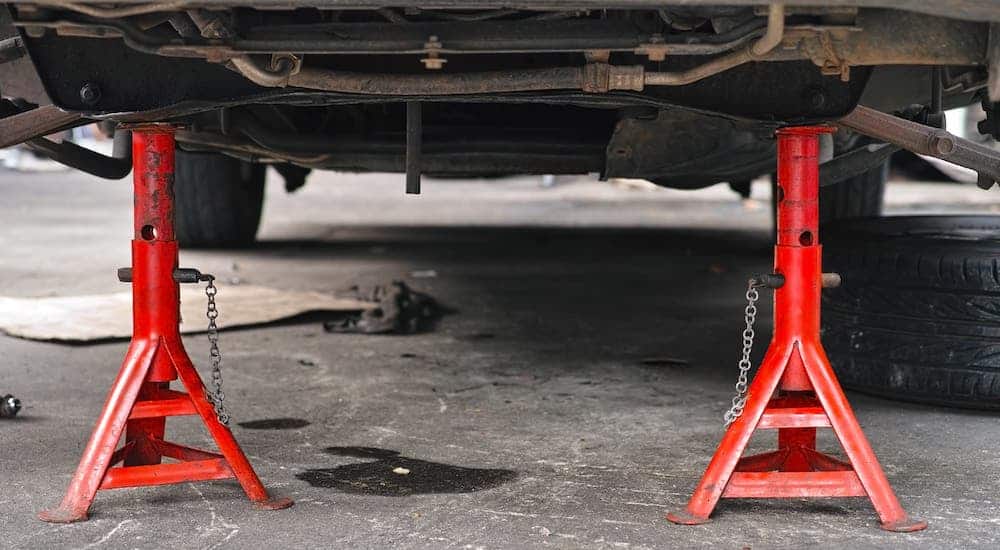Did you know that the Nissan Rogue is not only Nissan’s best-selling SUV, but it is the best-selling vehicle in the entire Nissan fleet? It is also the third best-selling SUV in America across all manufacturers. So, what makes it so popular? The Rogue is a compact crossover SUV that offers power, performance, and plenty of interior space for passengers and cargo. It’s also incredibly easy to maintain, as you’ll discover at your local Nissan service center.
However, you don’t always have to visit your closest service center for routine maintenance. One of the easiest aspects of maintaining your Nissan Rogue and ensuring its longevity is changing the oil. You can change the oil in your Rogue right at home by following the steps outlined below. The total process only requires some basic tools and can be accomplished quite quickly once you have some experience.
What You’ll Need
It’s a good idea to gather everything you need before you get started. You’ll need jack stands and a floor jack to raise and stabilize the vehicle. You’ll need a drain pan, a container for the old oil, and a clean rag. Reference your Rogue’s owner’s manual to determine the type of oil filter and the type and quantity of oil you’ll need. Gather the oil and filter as well as a 14mm socket, 3/8-in drive ratchet, and a wrench. If you have an oil filter wrench on hand, grab that as well, but it is not always necessary.
#1 Warming the Engine
The first step to changing the oil in your Nissan Rogue is simple. Park the Rogue on a level surface, apply the parking brake, and start the engine. Let the engine run for two to three minutes so that it reaches operating temperature. Once the engine is warmed up, turn the engine off and let the vehicle sit for 10 to 15 minutes.
While this step may not seem important, it does wonders to ensure a successful oil change. It is difficult to change cold oil, which does not flow easily out of the engine. By letting the engine idle, the oil warms up to approximately 100 degrees making it warm enough to flow. Be mindful that if you’ve driven your vehicle longer than two to three minutes, the oil will be incredibly hot. To avoid burning yourself, allow the vehicle to sit for 30 minutes before draining the oil.

#2 Raise and Secure Your Vehicle
If you have jack stands and know how to use them safely, raising the Rogue off the ground will make it easier to access underneath the vehicle. To do this, park the Rogue on a level surface, engage the parking brake, and place tire chocks or wedges around the rear wheels to prevent the Rogue from moving. Refer to the Rogue’s owner’s manual to locate the vehicle’s lift points. Once you locate the lift point, use the floor jack to raise the vehicle and then set the jack stands under the Rogue’s pinch points.
Once the jack stands are secure, slowly lower the vehicle onto the stands by turning the handle of the floor jack counterclockwise. Check the stability of the vehicle by nudging it to see if it shifts weight. If the stands are placed properly, the vehicle will not move when pushed. Never rely on a jack alone to support the weight of your vehicle.
#3 Drain the Oil
With the Rogue secure on the jack stands, raise the front hood, and locate the oil filler cap. Remove the cap, setting it aside in a safe place, and raise the dipstick out of the well at least an inch. Doing this will allow the oil to drain faster by preventing a vacuum effect.
You’ll need to work on the passenger side of the vehicle near the front tire behind the wheel well liner. Grab your 14 mm socket, a compatible ratchet, and a large basin for the oil (double-check to make sure the basin is large enough to contain all of the old oil – you don’t want it to overflow on you). After sliding under the passenger side of the car, locate the oil drain plug and oil filter. Carefully place your basin under the drain plug and remove the plug using the socket and ratchet. Put the plug in a safe place and allow the oil to drain completely.
#4 Change the Oil Filter
While you’re changing the oil on your Rogue, it’s also a good idea to change the oil filter. The filter is responsible for keeping your oil clean, and reusing an old filter will reduce the life of your new oil. Using an oil filter wrench, loosen the oil filter enough so that you can turn it by hand to remove. As you remove the filter, be sure to remove the old gasket and any residual materials left behind. Once the filter is removed, clean the mounting surface with a rag.
Before you install the new filter, use clean engine oil to coat the gasket on the new filter. This not only helps create a better seal and prevent leaks, but it also makes it easier to change the filter during the next oil change. Then charge the new filter by filling it with fresh oil – this will help protect your engine when you start it up again after the oil change. Once this is done, screw the filter in clockwise by hand until it is tight. Do not use a wrench to tighten the filter, as doing so can damage it.

#5 Adding Fresh Oil
Now that you’ve installed a new oil filter, it’s time to turn your attention back to the oil. Once the oil has drained fully, remove the basin with the old oil and clean the drain plug. Reinstall the plug with a fresh crush washer and tighten with a wrench to Nissan’s standard of 22 to 29 lb.-ft of torque. It’s important not to use excessive force when tightening the plug, or you may damage the threads. Once the drain plug is secure, locate the oil filler cap in the engine bay under the hood of the Rogue.
Using a funnel, refill the engine with the recommended grade and quantity of oil. Using too much or too little oil can result in damage to your engine, but it is much easier to fix having too little oil so start slow. Once you’ve poured in the new oil, temporarily replace the oil filler cap and dipstick.
#6 Check Your Work
After adding the fresh oil and securing the cap, it’s important to check your work. Start the engine and look under the vehicle for any leaks. You’ll want to carefully check for leaks around the filter and the drain plug. If there aren’t any leaks, turn the engine off and wait 10 to 15 minutes before checking the oil with the dipstick. Depending on the dipstick reading, you may have to add more engine oil but do it slowly in smaller increments.
Once the dipstick shows the appropriate amount of oil, you can close the hood of the Rogue and lower the vehicle off the jack stands. Clean up any tools used and properly dispose of the old oil and filter. It’s also a good idea to note the date and the Rogue’s mileage. That way, you can monitor the mileage and know exactly when your Rogue is due for its next oil change.
Regular Oil Changes
Now that you know the steps to change the oil in your Nissan, there’s nothing stopping you! After the first time you do it, the process will become second nature to you. It’ll also be a welcome task since it will save you money, give you a better idea of your vehicle’s health, and minimize the time spent at your local Nissan service department.

